Tanis
Forum Replies Created
-
TanisParticipant

 These images show how the course has wound its way into my life. The photograph was taken today because I love the colour of the cardinal flower and am still trying to capture it and paint it. Besides the book used for the course I now have one dedicated to wildflowers. This picture shows the information that I have started noting or researching about the flowers. Both painting and journalling were new to me but are becoming something I love to do now. So thank you to Liz for teaching us ways to improve our skills and to awakening me to journalling. This was a wonderful and enriching course. in reply to: Tips to Keep You Going #731381
These images show how the course has wound its way into my life. The photograph was taken today because I love the colour of the cardinal flower and am still trying to capture it and paint it. Besides the book used for the course I now have one dedicated to wildflowers. This picture shows the information that I have started noting or researching about the flowers. Both painting and journalling were new to me but are becoming something I love to do now. So thank you to Liz for teaching us ways to improve our skills and to awakening me to journalling. This was a wonderful and enriching course. in reply to: Tips to Keep You Going #731381 -
TanisParticipantThis reminds me of some of the work done by First Nations artists.in reply to: Tips to Keep You Going #731050
-
TanisParticipantWhat a great way to record your trip. I usually take photos and recently added journaling. The variety you captured with your pictures gives a fuller picture of the area you visited.in reply to: Tips to Keep You Going #731049
-
TanisParticipantYou must have developed a lot of patience to capture the swallow at this stage. Hope you continue to paint more of the birds that you have photographed because this one is wonderful.in reply to: Tips to Keep You Going #731043
-
TanisParticipantWe have a Phoebe which returns every year. It likes to watch us the way this one is watching the goats. Fun picture.in reply to: The Power of Reflection #730566
-
TanisParticipantThis reminds me of a Joni Mitchell song which often comes to me when I walk to the top of the hill and see the clouds. We are getting more stern clouds now. The end of August reminds men that the times are changing as well as the seasons. This was a very evocative submission.in reply to: The Power of Reflection #730561
-
TanisParticipant(In response to covid-19 I was looking for quiet road where I could jog and my dog could be unleashed. I found a spot and have returned to it 4 days a week since early April. Much of my drawing has been inspired by what I saw there and now I share part of it with you.) Island and I Early April Island: The ducks are back again, drifting beside me, she in brown, he with his dark head and glowing white eye patch, diving for food then, resurfacing and drifting again. Me: I park opposite this small island in the middle of the Madawaska River, off the gravel road, ready to run with Molly. My eyes are drawn to the river and what looks like chunks of snow floating on it. Eventually I realize that it is ducks but as I draw closer they lift and with a whistling sound quickly disappear. Island: Over the next few days more Goldeneye arrive and some mallard pairs, feeding and seeking places to raise their young. The woman has appeared often, parking her little green car, appearing now and again long the road, stepping out in a small clearing below me with her dog, then disappearing again. Me: I arrive quietly and slip out of the car, binoculars and bird book in hand trying for a clearer view so I can identify these ducks. Finally I decide they are Common Goldeneye. While I observe them for several weeks I never see their nests in hollow trees on the far side of the island nor their young, before they are gone. Early May Island: The Canada geese have arrived. Just a pair make their nest at the tip of me. The nest is away from the road so She will not see it. I wonder when the other pair will arrive. Me: I see a pair of Canada geese floating in a quiet spot at the end of the island. I will have to check it again and see when the young have hatched. When I go down the bank to a sandy stretch I am surprised to see so much black mixed with the pale sand. Looking closer I realize that it is hundreds of emerging black flies. Climbing the bank I lean against a cedar to stretch then see all the small black flies lining it as high as I can see. Hemlocks, maple and poplar are similarly covered. While I may not enjoy my run here next time, the birds should be happy. Early June: Island: I do enjoy the song of returning birds and seeing them flit among the bushes. Jays, kingfishers and sparrows, even wrens fly back and forth. Heron fly down the river and the occasional bald eagle sits atop my tall pines. I wonder if she sees them. Me: There is so much to see along the road. Just the flowers: rosa rugosa, starflowers thimbleweed and cardinal flowers. Some I know but others I have to look up in my wildflower book. Then there was the doe I was watching, lying in the shade on the road when another doe came up from the river right beside me! Both took off while I searched for young. Where are the young? Were these two escaping the deer flies? Another day as I was ending my run, a flutter of swallowtails rose up around me. What joy! They settled on a damp area on the road and could be found there for a couple of weeks. What drew them to that spot? It was no longer a puddle and did not seem to be a source of food? June 18 Island: She has sat there for a long time, looking at me and drawing. Will she capture the rapids and quiet areas which keep the fish and birds returning here? Will see notice my magnificent white pines? Me: It is hard to capture the variety of plants on the island; grasses, bushes, maple or oak and of course the tall white pines. The campers must love lying beneath them. I only wish I could see the other side where the Goldeneyes hid. The colour of the water and the rapids are particularly hard to capture. Three ducks flew up the rapids too quickly to identify. A white-crowned sparrow flits among the bushes beside me, while blue damsel flies dart from water to grass and a red squirrel chatters above me. Molly and I will return because I look forward to seeing more flowers emerge, birds flock up and trees change to their brilliant fall colours. But for today I say good-bye to the Island.in reply to: The Power of Reflection #730414
-
TanisParticipant

 I have learned so much from this course in terms of drawing, painting and observing when outdoors. My use of negative space, squint tests and checking proportions have developed in my drawing. This was my first exposure to watercolours and I am becoming more confident about using different techniques and mixing colours. Initially I felt that I had to finish the picture in one setting. Once I started working on it over several days I was more able to add more detail and experiment with the brushes and colours to achieve a more detailed picture. Doing the course over several months has been a good way to watch nature changing while developing my skills to capture it. in reply to: See How Far You’ve Come #729360
I have learned so much from this course in terms of drawing, painting and observing when outdoors. My use of negative space, squint tests and checking proportions have developed in my drawing. This was my first exposure to watercolours and I am becoming more confident about using different techniques and mixing colours. Initially I felt that I had to finish the picture in one setting. Once I started working on it over several days I was more able to add more detail and experiment with the brushes and colours to achieve a more detailed picture. Doing the course over several months has been a good way to watch nature changing while developing my skills to capture it. in reply to: See How Far You’ve Come #729360 -
TanisParticipant
 This is an island where my dog and I go for a run. I pack sketching pencils and paint kit in a backpack along with a camera. The things I often forget to take are a test paper and something to wipe the pen on to dry it so now I just use another page in the sketch book. Usually an hour is all the time I want to sit in one place so it helps to take photograph of the scene. When I get back home I can focus more on adding the details. Capturing the colour of the water, its movement and the sense of white water are areas that still need practise. in reply to: Filling Your Sketches with Color #725793
This is an island where my dog and I go for a run. I pack sketching pencils and paint kit in a backpack along with a camera. The things I often forget to take are a test paper and something to wipe the pen on to dry it so now I just use another page in the sketch book. Usually an hour is all the time I want to sit in one place so it helps to take photograph of the scene. When I get back home I can focus more on adding the details. Capturing the colour of the water, its movement and the sense of white water are areas that still need practise. in reply to: Filling Your Sketches with Color #725793 -
TanisParticipantThis is amazing, especially the way you have captured the fur. How did you achieve the colour for its pads?in reply to: Filling Your Sketches with Color #725773
-
TanisParticipantI am spending more time near lakes and rivers to beat the heat and for landscape painting. In this painting I like the way you have captured movement in the water. It is one thing that I am still trying to do.in reply to: Filling Your Sketches with Color #725769
-
TanisParticipant
 I have tried all three techniques but feel most comfortable with wet on dry. Wet-on-wet worked really well for doing the clouds in the Wasatch mountain picture. Wet-on-wet is still a challenge. Sometimes the brush is too dry and I pick up very little colour, other times it is too wet. In this picture of the Common Goldeneye I was able to apply a variety of techniques and felt more comfortable with how I was using the brush. The head of the duck is supposed to be iridescent green (looks black in the field) but that has been hard to achieve. Having fun trying though! in reply to: Getting Comfortable with Watercolor #694345
I have tried all three techniques but feel most comfortable with wet on dry. Wet-on-wet worked really well for doing the clouds in the Wasatch mountain picture. Wet-on-wet is still a challenge. Sometimes the brush is too dry and I pick up very little colour, other times it is too wet. In this picture of the Common Goldeneye I was able to apply a variety of techniques and felt more comfortable with how I was using the brush. The head of the duck is supposed to be iridescent green (looks black in the field) but that has been hard to achieve. Having fun trying though! in reply to: Getting Comfortable with Watercolor #694345 -
TanisParticipant
 This was my first experience with watercolours so the tips and demonstrations were particularly helpful. The first thing I did was to make colour swatches of the paints so I would have some idea of what they looked like. When it came to mixing the grays it was hard to decide whether blue or purple should be added and which one. The pink was also a challenge but drawing the surrounding colours into the pink helped to blend it in. It was a fun experience and I look forward to tackling the crocuses which are now appearing in our yard. The mountain picture is pretty daunting but I will start its pallet and see how it goes. in reply to: Capturing Nature’s Color Palettes #682468
This was my first experience with watercolours so the tips and demonstrations were particularly helpful. The first thing I did was to make colour swatches of the paints so I would have some idea of what they looked like. When it came to mixing the grays it was hard to decide whether blue or purple should be added and which one. The pink was also a challenge but drawing the surrounding colours into the pink helped to blend it in. It was a fun experience and I look forward to tackling the crocuses which are now appearing in our yard. The mountain picture is pretty daunting but I will start its pallet and see how it goes. in reply to: Capturing Nature’s Color Palettes #682468 -
TanisParticipant
 This was a surprising exercise because of the noticeable change from the original. Unfortunately the original has been erased . Using negative space and checking proportions comes most easily. I still have difficulty separating shading from colours. in reply to: Giving Your Drawings Depth #673159
This was a surprising exercise because of the noticeable change from the original. Unfortunately the original has been erased . Using negative space and checking proportions comes most easily. I still have difficulty separating shading from colours. in reply to: Giving Your Drawings Depth #673159 -
TanisParticipantGestures happen so quickly that you can only capture a part of it. It makes me focus on how they are doing something like the position of the kit's legs when it is tumbling. I found myself pausing the videos so I could capture more of the action. When I took photos of the birds at our feeder I tried to stop an action and draw from it later. This exercise helped me move beyond looking at colours and markings to thinking of their anatomy when it is moving.
 in reply to: Capturing Behavior – Gesture Drawing #666606
in reply to: Capturing Behavior – Gesture Drawing #666606 -
TanisParticipant

 After doing the course photos I decided that plants were easier to capture than animals.That did not prove true when I tried doing the horse and dieffenbachia. Both were difficult to contour draw. I tried using one finger as a guide to where I started but still had a hard time closing the gap. Legs were especially hard as the lines kept crossing over though the shape of them was there. Some of the points and curves of the plant and the mane of the horse captured the feel of what was being drawn. I think this will be an important part of what we are doing when trying to capture motion. in reply to: Focusing on Your Subject – Blind Contour Drawing #663043
After doing the course photos I decided that plants were easier to capture than animals.That did not prove true when I tried doing the horse and dieffenbachia. Both were difficult to contour draw. I tried using one finger as a guide to where I started but still had a hard time closing the gap. Legs were especially hard as the lines kept crossing over though the shape of them was there. Some of the points and curves of the plant and the mane of the horse captured the feel of what was being drawn. I think this will be an important part of what we are doing when trying to capture motion. in reply to: Focusing on Your Subject – Blind Contour Drawing #663043 -
TanisParticipantThis was a very interesting exercise. Comparing really helped me focus on the differences where before I just noticed the similarities. I decided to do a balsam fir and spruce because while I can recognize them from a distance I continually confuse them when walking through the woods. Sitting down and drawing the bark and noting the growth pattern of the needles has helped fix it in my mind. Since it was cool sitting outside for an extended time I brought the spruce bough inside to sketch and did the fir from memory. However then I began to question the accuracy of the fir drawing. Bringing in a branch helped me look closely and more deeply at it. This is an exercise that I will continue to do. After looking at some of the other work I see how my records need more numerical data.in reply to: The Power of Comparison #661617
-
TanisParticipant
 We put out apples for the deer and two deer show up on a regular basis. One is reddish coloured and the other has lots of black . The reddish one allows comes first. The darker one waits until the other finishes and moves away before approaching the apples. I wonder if the reddish deer is dominant so it eats first and decides when it is safe to eat and when it is time to leave.
I have heard that darker deer live in swampy areas but these two are travelling together so why is one so much darker. Is it younger?
in reply to: Noticing Themes in Nature #660388
We put out apples for the deer and two deer show up on a regular basis. One is reddish coloured and the other has lots of black . The reddish one allows comes first. The darker one waits until the other finishes and moves away before approaching the apples. I wonder if the reddish deer is dominant so it eats first and decides when it is safe to eat and when it is time to leave.
I have heard that darker deer live in swampy areas but these two are travelling together so why is one so much darker. Is it younger?
in reply to: Noticing Themes in Nature #660388 -
TanisParticipantWe have south facing windows which overlook a bird feeder and a place where we feed deer. At noon a deer approached the apples so I stayed inside and used this as my "sit spot". Later another deer came out and joined it. I was able to note their different appearance and behaviour. In the afternoon I moved outside (snow covered ground, 0 degrees and overcast)where I could observe both the feeder and the apples. Outside you could use your senses so much more fully. The chickadees where particularly chatty. I thought that writing up observations would take all the time, but somehow time slowed and I was able to sketch some trees and a bits of a bird. The trees I wanted to identify because I had wondered what the deer were eating besides the apples. Several blue jays came to the feeder and as I started to sketch their outstanding features as I noticed that not all were the same. Observing the shape of the birds' tails and the markings was the "outside of the box" for me. For example, it was hard to identify the colours of one bird because the overcast weather made colours indistinct. Instead I noted its size, bars on the wings and distance it kept from me. Observations certainly do lead to more questions!in reply to: Opening Your Senses #659252
-
TanisParticipant
 This partial paper wasp nest is one of the hardest things I have tried to draw and represents some of the problems I am still working on: how to make the central leg appear farther away, how to get a 3-D appearance while including the markings of the nest and how to make a bowl appearance where the top is off. Using cross hatching and dots along with hatching has been effective in other drawings. Contour hatching is something I want to work on more. Liz's videos are super helpful and these discussion groups are inspirational. in reply to: Illustrating the 3D World #658716
This partial paper wasp nest is one of the hardest things I have tried to draw and represents some of the problems I am still working on: how to make the central leg appear farther away, how to get a 3-D appearance while including the markings of the nest and how to make a bowl appearance where the top is off. Using cross hatching and dots along with hatching has been effective in other drawings. Contour hatching is something I want to work on more. Liz's videos are super helpful and these discussion groups are inspirational. in reply to: Illustrating the 3D World #658716

 These images show how the course has wound its way into my life. The photograph was taken today because I love the colour of the cardinal flower and am still trying to capture it and paint it. Besides the book used for the course I now have one dedicated to wildflowers. This picture shows the information that I have started noting or researching about the flowers. Both painting and journalling were new to me but are becoming something I love to do now. So thank you to Liz for teaching us ways to improve our skills and to awakening me to journalling. This was a wonderful and enriching course.
These images show how the course has wound its way into my life. The photograph was taken today because I love the colour of the cardinal flower and am still trying to capture it and paint it. Besides the book used for the course I now have one dedicated to wildflowers. This picture shows the information that I have started noting or researching about the flowers. Both painting and journalling were new to me but are becoming something I love to do now. So thank you to Liz for teaching us ways to improve our skills and to awakening me to journalling. This was a wonderful and enriching course. 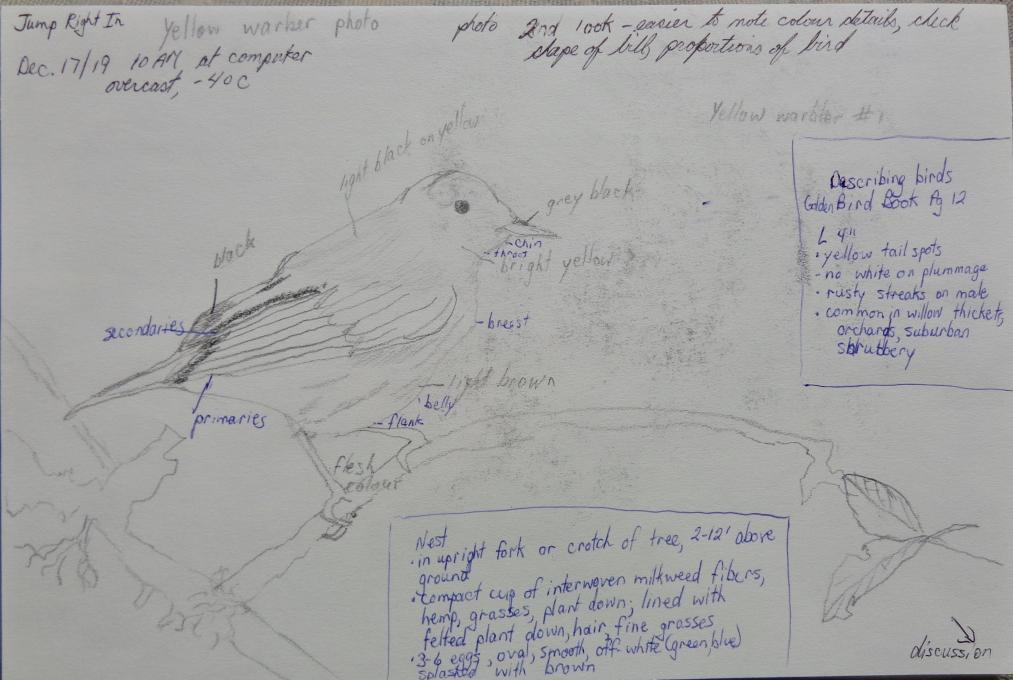
 I have learned so much from this course in terms of drawing, painting and observing when outdoors. My use of negative space, squint tests and checking proportions have developed in my drawing. This was my first exposure to watercolours and I am becoming more confident about using different techniques and mixing colours. Initially I felt that I had to finish the picture in one setting. Once I started working on it over several days I was more able to add more detail and experiment with the brushes and colours to achieve a more detailed picture. Doing the course over several months has been a good way to watch nature changing while developing my skills to capture it.
I have learned so much from this course in terms of drawing, painting and observing when outdoors. My use of negative space, squint tests and checking proportions have developed in my drawing. This was my first exposure to watercolours and I am becoming more confident about using different techniques and mixing colours. Initially I felt that I had to finish the picture in one setting. Once I started working on it over several days I was more able to add more detail and experiment with the brushes and colours to achieve a more detailed picture. Doing the course over several months has been a good way to watch nature changing while developing my skills to capture it.  This is an island where my dog and I go for a run. I pack sketching pencils and paint kit in a backpack along with a camera. The things I often forget to take are a test paper and something to wipe the pen on to dry it so now I just use another page in the sketch book. Usually an hour is all the time I want to sit in one place so it helps to take photograph of the scene. When I get back home I can focus more on adding the details. Capturing the colour of the water, its movement and the sense of white water are areas that still need practise.
This is an island where my dog and I go for a run. I pack sketching pencils and paint kit in a backpack along with a camera. The things I often forget to take are a test paper and something to wipe the pen on to dry it so now I just use another page in the sketch book. Usually an hour is all the time I want to sit in one place so it helps to take photograph of the scene. When I get back home I can focus more on adding the details. Capturing the colour of the water, its movement and the sense of white water are areas that still need practise. 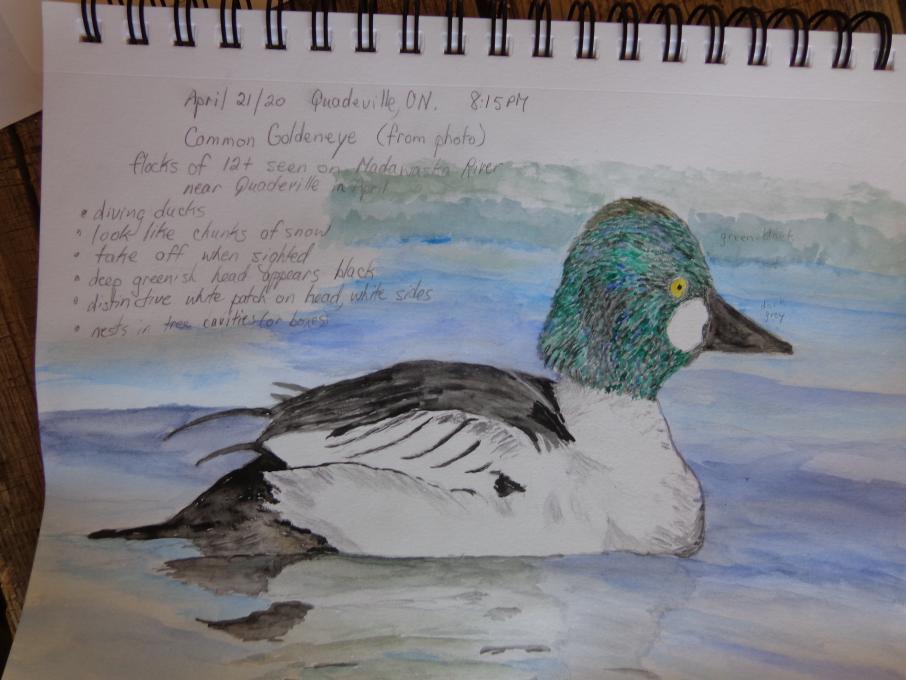 I have tried all three techniques but feel most comfortable with wet on dry. Wet-on-wet worked really well for doing the clouds in the Wasatch mountain picture. Wet-on-wet is still a challenge. Sometimes the brush is too dry and I pick up very little colour, other times it is too wet. In this picture of the Common Goldeneye I was able to apply a variety of techniques and felt more comfortable with how I was using the brush. The head of the duck is supposed to be iridescent green (looks black in the field) but that has been hard to achieve. Having fun trying though!
I have tried all three techniques but feel most comfortable with wet on dry. Wet-on-wet worked really well for doing the clouds in the Wasatch mountain picture. Wet-on-wet is still a challenge. Sometimes the brush is too dry and I pick up very little colour, other times it is too wet. In this picture of the Common Goldeneye I was able to apply a variety of techniques and felt more comfortable with how I was using the brush. The head of the duck is supposed to be iridescent green (looks black in the field) but that has been hard to achieve. Having fun trying though! 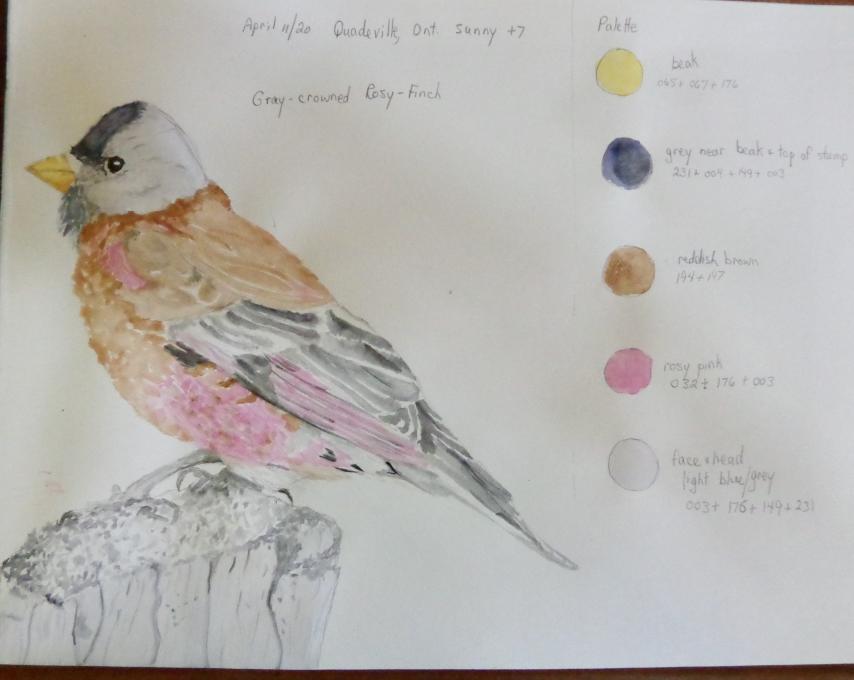 This was my first experience with watercolours so the tips and demonstrations were particularly helpful. The first thing I did was to make colour swatches of the paints so I would have some idea of what they looked like. When it came to mixing the grays it was hard to decide whether blue or purple should be added and which one. The pink was also a challenge but drawing the surrounding colours into the pink helped to blend it in. It was a fun experience and I look forward to tackling the crocuses which are now appearing in our yard. The mountain picture is pretty daunting but I will start its pallet and see how it goes.
This was my first experience with watercolours so the tips and demonstrations were particularly helpful. The first thing I did was to make colour swatches of the paints so I would have some idea of what they looked like. When it came to mixing the grays it was hard to decide whether blue or purple should be added and which one. The pink was also a challenge but drawing the surrounding colours into the pink helped to blend it in. It was a fun experience and I look forward to tackling the crocuses which are now appearing in our yard. The mountain picture is pretty daunting but I will start its pallet and see how it goes. 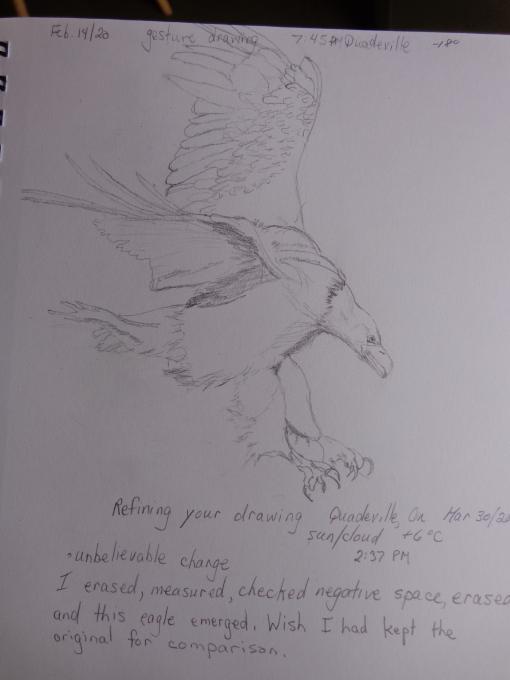 This was a surprising exercise because of the noticeable change from the original. Unfortunately the original has been erased . Using negative space and checking proportions comes most easily. I still have difficulty separating shading from colours.
This was a surprising exercise because of the noticeable change from the original. Unfortunately the original has been erased . Using negative space and checking proportions comes most easily. I still have difficulty separating shading from colours. 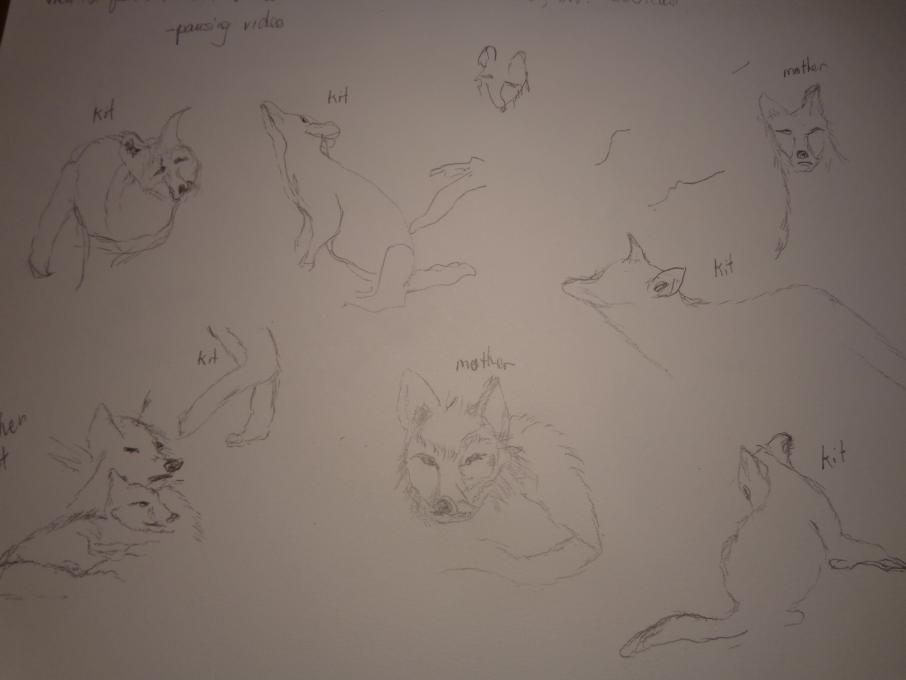
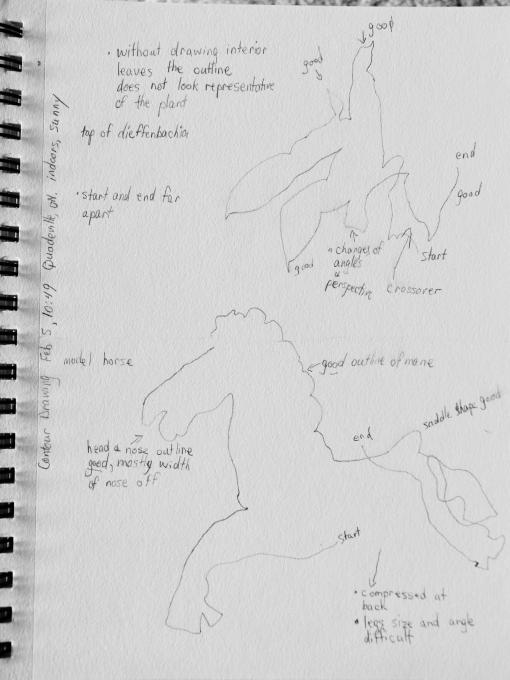
 After doing the course photos I decided that plants were easier to capture than animals.That did not prove true when I tried doing the horse and dieffenbachia. Both were difficult to contour draw. I tried using one finger as a guide to where I started but still had a hard time closing the gap. Legs were especially hard as the lines kept crossing over though the shape of them was there. Some of the points and curves of the plant and the mane of the horse captured the feel of what was being drawn. I think this will be an important part of what we are doing when trying to capture motion.
After doing the course photos I decided that plants were easier to capture than animals.That did not prove true when I tried doing the horse and dieffenbachia. Both were difficult to contour draw. I tried using one finger as a guide to where I started but still had a hard time closing the gap. Legs were especially hard as the lines kept crossing over though the shape of them was there. Some of the points and curves of the plant and the mane of the horse captured the feel of what was being drawn. I think this will be an important part of what we are doing when trying to capture motion.  We put out apples for the deer and two deer show up on a regular basis. One is reddish coloured and the other has lots of black . The reddish one allows comes first. The darker one waits until the other finishes and moves away before approaching the apples. I wonder if the reddish deer is dominant so it eats first and decides when it is safe to eat and when it is time to leave.
I have heard that darker deer live in swampy areas but these two are travelling together so why is one so much darker. Is it younger?
We put out apples for the deer and two deer show up on a regular basis. One is reddish coloured and the other has lots of black . The reddish one allows comes first. The darker one waits until the other finishes and moves away before approaching the apples. I wonder if the reddish deer is dominant so it eats first and decides when it is safe to eat and when it is time to leave.
I have heard that darker deer live in swampy areas but these two are travelling together so why is one so much darker. Is it younger?
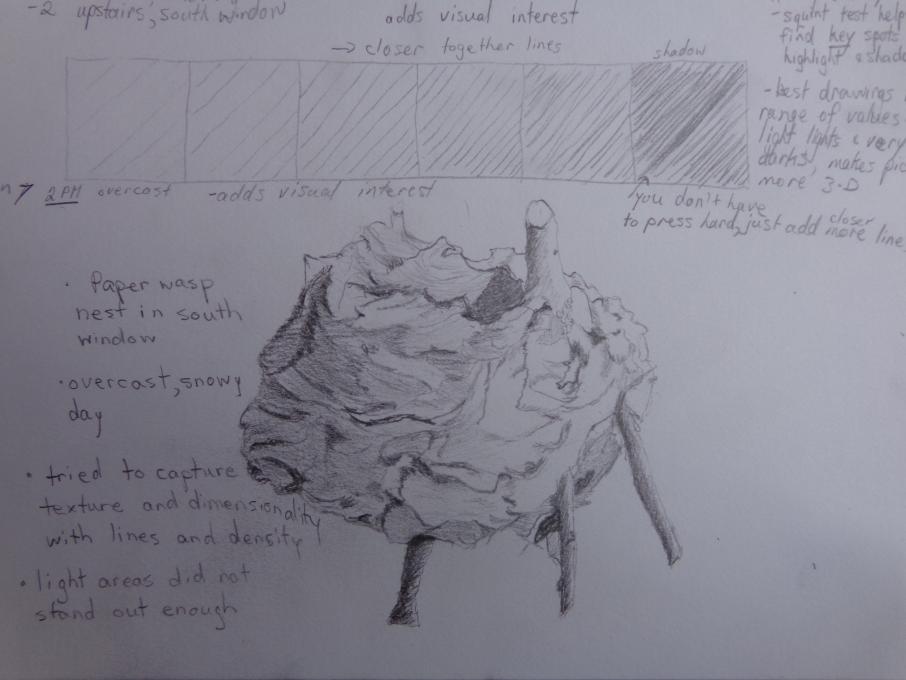 This partial paper wasp nest is one of the hardest things I have tried to draw and represents some of the problems I am still working on: how to make the central leg appear farther away, how to get a 3-D appearance while including the markings of the nest and how to make a bowl appearance where the top is off. Using cross hatching and dots along with hatching has been effective in other drawings. Contour hatching is something I want to work on more. Liz's videos are super helpful and these discussion groups are inspirational.
This partial paper wasp nest is one of the hardest things I have tried to draw and represents some of the problems I am still working on: how to make the central leg appear farther away, how to get a 3-D appearance while including the markings of the nest and how to make a bowl appearance where the top is off. Using cross hatching and dots along with hatching has been effective in other drawings. Contour hatching is something I want to work on more. Liz's videos are super helpful and these discussion groups are inspirational.